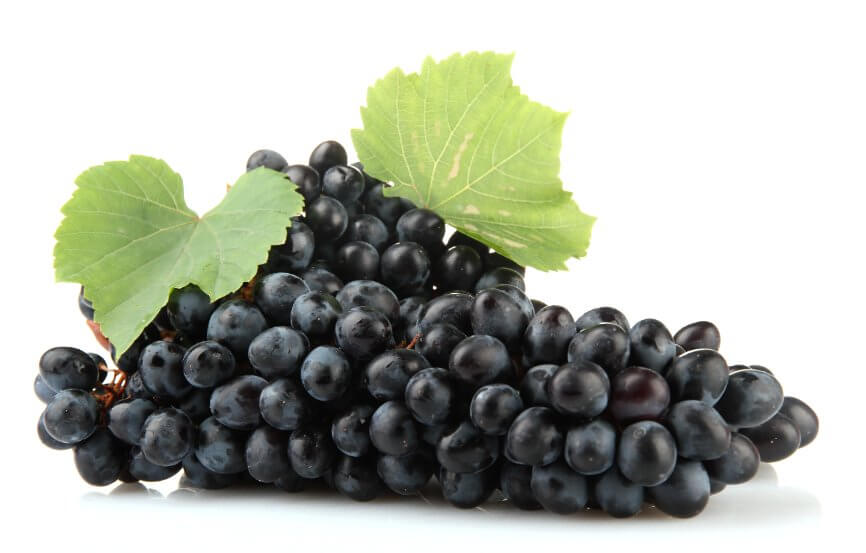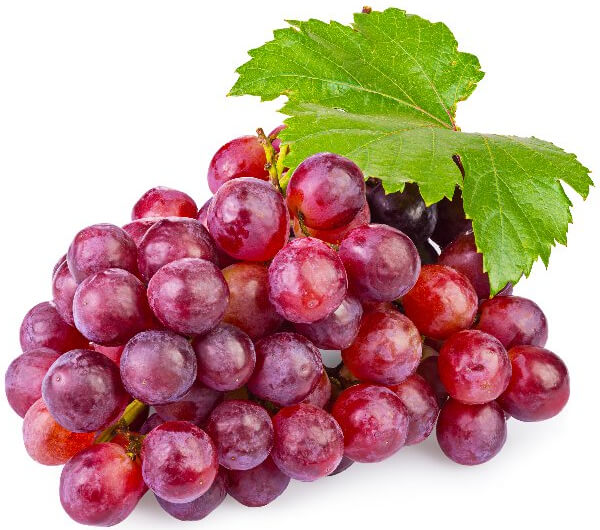Grapes are not unlike other types of fruits in that they come in many different shapes, sizes, and colors. Two such varieties would be black grapes and red grapes– both of which may be easy to confuse for each other due to their similarities in appearance. However, these two grape varieties are actually very different, and in this article we’ll be going over all of the differences between black grapes vs red grapes so you’ll be able to distinguish them more easily.
In short, the difference between black grapes vs red grapes is that the black variety is smaller, darker in color, usually contains seeds, and are most commonly used for making wine. Red grapes, on the other hand, are usually seedless and are meant for snacking. Additionally, black grapes contain significantly more vitamin C and calcium than red grapes.
That said, there are many other differences between these two grape varieties that may be of interest to you. Let’s have a closer look.
What Exactly Are Black Grapes?
Black grapes, also known as Black Spanish grapes, are a grape variety that dates back to the 1800s. Despite their name, however, they originate in America and are mostly grown in the southern region– particularly Texas.

Black Spanish grapes are smaller in appearance than typical grape varieties, such as red and green. They grow in clusters and contain a high concentration of antioxidants known as anthocyanins that are responsible for giving them their dark blue (or sometimes purple) color.
How They’re Used
Possibly the biggest difference between black grapes vs red grapes (aside from their appearance) is how they’re used.
Black grapes are unique in that they aren’t as commercially available in grocery stores and markets as other varieties are, such as red and green grapes. Instead, they’re mostly grown in vineyards and are used to make dark red and port-style wines.
What makes black grapes preferable for wine making compared to other types of grapes is their disease resistance. One such disease would be Pierce’s Disease— a condition in which grapevines are killed due to a bacteria that causes its water vessels to become clogged.
How They Taste
Another difference between black and red grapes is their taste. Black grapes are described as having a slightly sweeter and more tangy taste than red grapes.
Black grapes usually contain seeds, although seedless varieties do exist. Although the seeds are edible and unlikely to cause harm, they do have a strong, bitter taste.
Potential Health Benefits
Black grapes are certainly not without their health benefits. For example, black grapes contain significantly more antioxidants than red grapes, according to WebMD. Antioxidants help protect cells from free radical damage.
One such antioxidant would be resveratrol, which is found in the skin of both black and red grapes and is believed to offer protection to both the heart and the brain. Additionally, it can help fight viruses, inflammation, and even cancer, says WebMD.
Storage & Shelf Life
Black grapes are not unlike other grape varieties when it comes to storage and shelf life. The All Recipes website recommends storing them in the refrigerator at temperatures between 30F and 32F. They have a tendency to absorb odors from other foods, so the more isolated they are, the better.
When properly stored, black grapes can last for up to 3 weeks, and even longer when frozen.
Pet Safety
Another trait shared by both black and red grapes is their toxicity to our four-legged friends. The American Kennel Club says that dogs should never eat grapes. Just a single grape can be fatal.
All About Red Grapes
Red grapes, also known as red seedless grapes, are one of the most popular grape varieties among consumers. They are small and oblong with a reddish (or burgundy) skin that sometimes contains a dusty film that protects it from water and cracking.

The seedless variety of red grape is the result of cutting with other seedless grape varieties, such as the Thompson seedless. Seedless grapes were engineered in the late 1800s to meet consumer demand, which paid off as red seedless grapes have since become a staple in many kitchens.
How They’re Used
Red grapes differ from black grapes in that they’re more commercially available in grocery stores and farmers’ markets. They are most commonly eaten out-of-hand as a delicious and healthy snack, although they are also used in a variety of other ways, including:
- As table grapes
- Used to make grape juice
- Made in jams, jellies, and spreads
- Dried to make raisins
Furthermore, red grapes are also used to make dark red wines just as black grapes are, however, they provide an alternate flavor.
How They Taste
Red grapes are possibly the most flavorful and palatable grape variety. They are sweeter than most other grapes, yet they do not contain the tart flavor of green grapes or the tangy taste of black grapes. This makes them a popular choice for snacking.
Potential Health Benefits
Much like black grapes, red grapes come with health benefits as well.
According to WebMD, red grapes are good for:
- Cardiovascular health
- Diabetes control
- Weight management
Red grapes also contain antioxidants such as resveratrol, as well as flavonoids that are believed to reduce inflammation and can even relax blood vessels.
Storage & Shelf Life
Another area where there’s not much of a difference between black grapes vs red grapes is their storage and shelf life.
When stored in perforated packaging, red grapes can last for up to 3 weeks in the refrigerator or up to 12 months in the freezer.
Pet Safety
Grapes of all kinds are toxic to dogs, including red grapes. However, the exact reason why is unknown.
Nutrition Facts
Now that we’ve gone over all of the practical differences between black grapes and red grapes, let’s have a look at how they compare nutritionally.
The table below compares the nutrition facts for a 1-cup serving of black grapes compared with an equal serving size of red grapes:
| Item | Black Grapes | Red Grapes |
| Serving Size | 1 Cup | 1 Cup |
| Calories | 60 | 64.6 |
| Total Carbohydrates | 16g | 16.9g |
| Fiber | 0.7g | 0.8g |
| Sugar | 15.3g | 14.4g |
| Total Fat | 0.7g | 0.2g |
| Saturated Fat | 0g | 0.1g |
| Protein | 0.7g | 0.7g |
| Vitamin A | 1.3% DV | 1.2% DV |
| Vitamin C | 16.7% DV | 4.9% DV |
| Calcium | 1.3% DV | 0.7% DV |
| Iron | 1.3% DV | 1.9% DV |
| Potassium | N/A | 178.6mg |
As you can see, both grape varieties are nearly identical in terms of nutritional contents:
- They’re each relatively low in calories, which is useful for weight management.
- They’re low in total fat and hardly contain any saturated fat.
- They’re both good sources of potassium, which can help lower blood pressure, according to Harvard Health Publishing.
- They both contain vitamins and minerals.
That said, black grapes do have a couple of nutritional advantages over red grapes which may be worth considering.
Black Grapes Contain Triple The Vitamin C Content
Possibly the greatest nutritional advantage that black grapes have over red grapes is their vitamin C content.
Vitamin C, also known as ascorbic acid, is an essential nutrient and antioxidant that plays a role in immune health. It also helps the body make collagen and protect cells from free radical damage, according to the National Institutes of Health.
If getting more vitamin C is a priority for you then you’ll be better served opting for black grapes vs red grapes as they contain more than triple the vitamin C content, clocking in at 16.7% of the Daily Value per cup. Red grapes, by comparison, only contain 4.9%.
Black Grapes Also Contain More Calcium Than Red Grapes
Finally, black grapes contain more calcium per serving than red grapes.
Calcium is an essential mineral that is stored in the bones and teeth and plays a role in bone health. It also helps nerves communicate with the brain and every other part of the body.
While neither grape variety is a stellar source of calcium, black grapes do contain nearly double the calcium content of red grapes, clocking in at 1.3% DV and 0.7% DV respectively.
Black Grapes VS Red Grapes: In Summary
Now that we’ve gone over all of the differences, let’s briefly review the key differences we’ve gone over:
| Item | Black Grapes | Red Grapes |
 |
 |
|
| Appearance | Tiny, round, dark blue/purple | Oblong in shape, reddish.burgundy color with a dusty film |
| How they’re used | Mostly used in winemaking | Snacking, made into grape juice, jams, jellies, and spreads |
| Contains seeds/pits? | Yes, although seedless varieties exist | Mostly seedless, although some varieties contain seeds |
| Health benefits | Contains antioxidants (such as resveratrol) that promote heart and brain health | Contains antioxidants (such as resveratrol) that promote heart and brain health |
| Nutritional benefits | Contains more vitamin C and calcium | Good source of potassium |
| Origination | Dates back to the 1800s, grown in the southern U.S. (mostly Texas) | Originates in the U.S. and were engineered to be seedless in the 1800s |
| Difference in taste | Sweeter, more tangy | Also sweet but not as tangy |
| Storage & Shelf Life | Up to 3 weeks in the refrigerator and 12 months in the freezer | Up to 3 weeks in the refrigerator and 12 months in the freezer |
| Pet Safety | Highly toxic to dogs | Highly toxic to dogs |
The Bottom Line
Despite their differences, both black grapes and red grapes have much to offer in terms of nutrition and health benefits. They’re also excellent choices for winemaking, snacking, and other culinary uses.
Whether you choose one over the other, or both, you simply cannot go wrong. Just make sure to keep them away from your pets!

